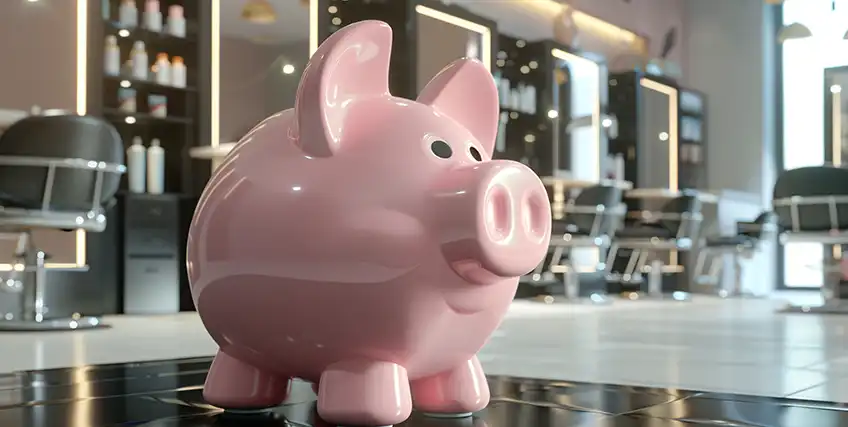
One industry that is gaining popularity and profitability among entrepreneurs today is beauty and personal care. According to Statista, the global market for beauty and personal care businesses is expected to be valued at a record high of over $768.5 billion by 2029, with States like Georgia leading this growing trend with businesses like spas.
Professional spas can include day spas, medispas, wellness centers, and more. Here’s a look at the pros and cons of opening your own spa in a State like Georgia and what it takes to make a spa industry dream profitable.
Types of Spas
The term "spa" can mean different things to different business owners. In general, a professional spa focuses on providing products and services that benefit its customers’ health and well-being — a definition that can even include barbershops. Most spas can be divided into a handful of common categories.
Day spas
When most people think about heading to the spa, they have a day spa in mind. Day spas offer on-demand services, including massages, face and body treatments, waxing, nail , and other spa treatments. They may also provide saunas, steam rooms, pools, hot tubs, and other experiential services.
Day spas are typically operated out of a retail location, which may be leased or owned, and customers might be local shoppers who become regular clients. Day spas can also be located in a hotel or resort, where the majority of clients are temporary guests.
Destination and resort spas
Destination and resort spas offer spa services to guests during extended visits or vacations. These facilities may be larger and more luxurious than day spas, and they are staffed to offer appointments to travelers on short notice.
In addition to traditional spa services like facials, massages, and seaweed wraps, a destination spa may offer exercises like yoga, meditation groups, health- and wellness-centered activities, and healthy food or juices.
Medical spas
Medical spas, also known as medispas or medspas, offer various cosmetology services including peels, massage therapy, microdermabrasion, injectables, and laser treatments. The focus of medispas may be health and well-being, beauty, or even weight loss. Medical spas have at least one licensed medical practitioner on staff, depending on the scope of services offered.
Mineral and thermal spring spa
Some spas are built around naturally occurring mineral spas and thermal springs. Bathing in these mineral-rich waters is known to provide pain relief, cure certain ailments, and beautify the skin and hair.
Advantages of owning a spa
Turning your spa passion into an income-generating business comes with many benefits.
Earning potential
Entrepreneurs who open their own spas unlock the potential for unlimited earnings. In addition to entering a profitable global market, spa owners can decide which services they offer, the hours their business operates, and when to consider expansion. Each of those decisions can affect the earning potential of the business and growth strategies, like marketing campaigns, can be implemented at the owner’s discretion.
Career growth
Owning a spa is a sure way to have control over your career growth and the focus of your company. By owning your own spa rather than working for someone else, you’ll also have control over how the business is run, your ideal clientele, and how your personal skills develop.
Decision making
Working for yourself means you have the final say in all decisions that affect your business. For example, when you first set up your business, you can choose between sole proprietorship, partnership, corporation, or limited liability company (LLC). Choosing the business structure of your spa will allow you to control how your entity will pay income taxesand whether or not you will hire employees. And that’s just your first decision!
Licensing requirements
There is no formal education required to own a spa. However, there are licensing and certification requirements for practitioners of some services. Spa owners can decide if they will hold these required licenses and certifications themselves or simply hire individuals with the necessary credentials.
Disadvantages of owning a spa
While there are many benefits to owning a spa, there are also some disadvantages to note.
Administrative work
Small business owners take on a lot of responsibility, and when you open a spa, there is more than just providing great services to your clients. Entrepreneurs are also responsible for bookkeeping, insurance compliance, ordering, scheduling, and making decisions. When you have a spa business involving clients’ health, wellness, and even medical care, your requirements, obligations, and even liability increase.
Staffing decisions
Deciding whether or not to hire employees can be challenging for new business owners. Spas typically operate with more than one staff member working at a time, so as the owner, you need to decide if they will be employees or contractors. The business owner must also decide whether to hire a spa manager or fill that role themselves, especially if a licensed medical director is required.
Competition
It's helpful to create a thorough spa business plan on your own or use a template which will identify potential competitors in your target market. This will help you understand where to niche down, target specific customers with specific products and services, and set your prices. If you don’t understand your position in the market, you risk being run out of business by neighboring spas.
Licensing and oversight
Every business must meet local, state, and federal requirements for licenses and permits to operate. Since spas provide health and sometimes medical services, these requirements can be stricter than other business categories.
In Georgia, for example, you may need a business license, health permits, occupancy certificates, and/or meet zoning requirements to run your business. If you provide certain services, a medical license will also be mandatory. Some other licenses that may be required in a spa environment include:
- Licenses for massage therapists
- Cosmetology license
- Esthetician and/or aesthetician licenses
How much does it cost to open a spa?
According to Sharpsheets.com, the average cost to open a spa is $155,000 to $552,000 plus operating costs. Your spa business costs will depend on several factors, including the type of spa you plan to run, the size and location of your spa, your business model, and the services you want to offer.
For example, opening a large day spa business with eight treatment rooms will cost more than sharing a space with other cosmetologists. A salon business providing nail services and facials will likely have lower startup costs than if you need to purchase lasers and other equipment. Some startup expenses to consider when preparing to open a spa include:
- Licensing and permit costs
- Buying or leasing commercial real estate space
- Styling tools
- High-quality beauty salon chairs
- Massage tables
- Waiting room furniture
- Locker and changing rooms
- Advertising and marketing expenses
- Renovations and remodels
- Signage
- Lasers for face/body treatments and hair removal
- Sanitization stations
How to get the money to open a spa
No doubt opening a spa takes a significant investment, but no matter how much (or how little) you have in your bank account, finding the funds for your dream business is possible through crowdfunding or even taking out a loan for a new spa. Here are a few of the ways entrepreneurs can finance a new spa business.
Personal savings
Using your personal funds is perhaps the easiest way to fund the opening of a new spa if you have access to savings accounts, investments, or other assets that can be sold or leveraged. In that case, these personal savings offer no-strings-attached funding for your business needs. Funding a new spa from your personal savings may be easy and more affordable, but there’s also a lot of risk involved. If you use your emergency fund or retirement account to fund your spa and the business fails, you may find yourself in a tricky spot financially.
Crowdfunding
Crowdfunding is a method of raising money by collecting small donations or investments from several different sources, such as friends, family, or others in your community. Crowdfunding has gained popularity among new entrepreneurs in recent years thanks to sites like GoFundMe and Kickstarter.
Small business financing
The most common solution for funding a startup is to secure a small business loan. Business loan options are available through banks, credit unions, or online lenders, and loans for spas can be secured by collateral assets or unsecured.
Applying for a small business loan for a spa will give you the working capital you need for a variety of purposes, like if you need to:
- Supplement entry-level cash flow
- Pay operational expenses
- Purchase equipment or real estate
- Fund marketing strategies
- Buy spa service supplies and tools
- Hire staff
- Pay franchising fees
The most common financing options for small business owners include business term loans, SBA loans, and revolving business lines of credit.
Business term loans
Term loans for spas give borrowers funds in a lump sum that must be paid back in installments over a preset period. These business installment loans can be short- or long-term and may be either secured loans that require collateral or unsecured.
The financing costs of a term loan include interest, often expressed as an annual percentage rate (APR) that can be fixed or variable. Your loan’s interest rate is at least partially determined by the creditworthiness (and credit score) of the borrower, as well as the repayment term and loan amount chosen. Other costs might include origination fees and early prepayment penalties.
SBA loans
The U.S. Small Business Administration facilitates several loan programsthat partially guarantee a percentage of funds for approved borrowers. SBA loans for spas offer lower interest rate funding with smaller down payments than traditional bank loans. The most common SBA loans for new business owners are the SBA 7(a) loan and SBA microloans; between them, these government-backed loans offer anywhere from $500 to $5 million in business funding to qualified borrowers.
Revolving credit
Entrepreneurs looking to open a spa might consider two primary types of revolving credit: business credit cards or a business line of credit.
- Business lines of credit - Business borrowers are approved for a maximum line of credit through an online small business lender, bank, or credit union. As long as the line of credit is open, they can withdraw cash against this limit anytime. The monthly payments on a line of credit are made up of principal and interest, which is only calculated on the amount of cash borrowed; if you don’t ever pull from the line of credit, you won’t pay any interest.
- Business credit card - Borrowers can use a business credit card to purchase any amount up to their preapproved credit limit. These cards can be a great tool for business owners to finance startup costs, build good business credit history, and provide a financial safety net in case emergency expenses arise. Credit cards with rewards can offer additional incentives like cash back or points.
Final thoughts
Opening a spa provides business owners with a path toward financial independence, along with unlimited earning potential and career growth. Opening even a small spa can come with a hefty price tag, requiring funds for startup costs, spa equipment, furniture, marketing, and working space. If you can’t afford to cover these costs out of pocket and need a business loan in Georgia for your spa, crowdfunding or borrowing cash from a business lender can get you there.
FAQs on Opening a Spa
What is the success rate of a spa business?
According to the U.S. Bureau of Labor Statistics, the average failure rate of new businesses is 15.4% in the first year, meaning that nearly 85% of new businesses will survive at least year one. Whether or not your spa business will succeed depends on factors like location, services offered, and clientele.
Can I take out a loan to open a spa business?
Small business loans for spas are available through banks, credit unions, and online lenders, offering upfront lump sum funds or revolving lines of credit to new spa owners. These funds can be used to pay franchise fees, purchase or rent commercial space, hire employees, build out the business, purchase new equipment, and more. You can also look into alternative funding solutions like equipment financing if you are buying specific items and don’t have good credit or prefer a secured loan.
What’s required to open a spa?
The requirements for a new spa business depend on local, city, county, state, and federal requirements. Generally, you should expect to file for a business license, meet health code requirements, and get an occupancy certificate. Depending on the services offered, employees may also need cosmetology and medical licenses.
How much do I need to invest in a new spa?
On average, it costs between $155,000 and $552,000 to open a new spa, which includes securing space, purchasing equipment, paying for licensing, hiring employees, marketing, and more. Your actual costs will vary based on the type of business you plan to open, the services you will offer, your location and whether you’ll be a franchise.



